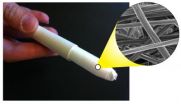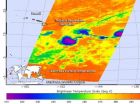(Press-News.org) One of the famous examples of the weirdness of quantum mechanics is the paradox of Schrödinger's cat.
If you put a cat inside an opaque box and make his life dependent on a random event, when does the cat die? When the random event occurs, or when you open the box?
Though common sense suggests the former, quantum mechanics – or at least the most common "Copenhagen" interpretation enunciated by Danish physicist Neils Bohr in the 1920s – says it's the latter. Someone has to observe the result before it becomes final. Until then, paradoxically, the cat is both dead and alive at the same time.
University of California, Berkeley, physicists have for the first time showed that, in fact, it's possible to follow the metaphorical cat through the whole process, whether he lives or dies in the end.
"Gently recording the cat's paw prints both makes it die, or come to life, as the case may be, and allows us to reconstruct its life history," said Irfan Siddiqi, UC Berkeley associate professor of physics, who is senior author of a cover article describing the result in the July 31 issue of the journal Nature.
The Schrödinger's cat paradox is a critical issue in quantum computers, where the input is an entanglement of states – like the cat's entangled life and death– yet the answer to whether the animal is dead or alive has to be definite.
"To Bohr and others, the process was instantaneous – when you opened the box, the entangled system collapsed into a definite, classical state. This postulate stirred debate in quantum mechanics," Siddiqi said. "But real-time tracking of a quantum system shows that it's a continuous process, and that we can constantly extract information from the system as it goes from quantum to classical. This level of detail was never considered accessible by the original founders of quantum theory."
For quantum computers, this would allow continuous error correction. The real world, everything from light and heat to vibration, can knock a quantum system out of its quantum state into a real-world, so-called classical state, like opening the box to look at the cat and forcing it to be either dead or alive. A big question regarding quantum computers, Siddiqi said, is whether you can extract information without destroying the quantum system entirely.
"This gets around that fundamental problem in a very natural way," he said. "We can continuously probe a system very gently to get a little bit of information and continuously correct it, nudging it back into line, toward the ultimate goal."
Being two opposing things at the same time
In the world of quantum physics, a system can be in two superposed states at the same time, as long as no one is observing. An observation perturbs the system and forces it into one or the other. Physicists say that the original entangled wave functions collapsed into a classical state.
In the past 10 years, theorists such as Andrew N. Jordan, professor of physics at the University of Rochester and coauthor of the Nature paper, have developed theories predicting the most likely way in which a quantum system will collapse.
"The Rochester team developed new mathematics to predict the most likely path with high accuracy, in the same way one would use Newtown's equations to predict the least cumbersome path of a ball rolling down a mountain," Siddiqi said. "The implications are significant, as now we can design control sequences to steer a system along a certain trajectory. For example, in chemistry one could use this to prefer certain products of a reaction over others."
Lead researcher Steve Weber, a graduate student in Siddiqi's group, and Siddiqi's former postdoctoral fellow Kater Murch, now an assistant professor of physics at Washington University in St. Louis, proved Jordan correct. They measured the trajectory of the wave function of a quantum circuit – a qubit, analogous to the bit in a normal computer – as it changed. The circuit, a superconducting pendulum, could be in two different energy states and was coupled to a second circuit to read out the final voltage, corresponding to the pendulum's frequency.
"If you did this experiment many, many times, measuring the road the system took each time and the states it went through, we could determine what the most likely path is," Siddiqi said. "Then we could design a control sequence to take the road we want to take for a given quantum evolution."
If you probed a chemical reaction in detail, for example, you could find the most likely path the reaction would take and design a way to steer the reaction to the products you want, not the most likely, Siddiqi said.
"The experiment demonstrates that, for any choice of final quantum state, the most likely or 'optimal path' connecting them in a given time can be found and predicted," Jordan said. "This verifies the theory and opens the way for active quantum control techniques."
INFORMATION:
The work was supported in part by the Office of Naval Research and the Office of the Director of National Intelligence (ODNI) of the Intelligence Advanced Research Projects Activity (IARPA), through the Army Research Office.
Watching Schrödinger's cat die (or come to life)
Steering quantum evolution & using probes to conduct continuous error correction in quantum computers
2014-07-30
ELSE PRESS RELEASES FROM THIS DATE:
Fear of losing money, not spending habits, affects investor risk tolerance, MU study finds
2014-07-30
As the U.S. economy slowly recovers, many investors remain wary about investing in the stock market. Investors' "risk tolerance," or their willingness to take risks, is an important factor for investors deciding whether, and how much, to invest in the stock market. Now, Michael Guillemette, an assistant professor of personal financial planning in the University of Missouri College of Human Environmental Sciences, along with David Nanigian, an associate professor at the American College, analyzed the causes of risk tolerance and found that loss aversion, or the fear of losing ...
When cooperation counts
2014-07-30
Everybody knows the shortest distance between two points is a straight line, and now Harvard researchers have evidence that sperm have been taking the familiar axiom to heart.
Though competition among individual sperm is usually thought to be intense, with each racing for the chance to fertilize the egg, Harvard scientists say in some species, sperm form cooperative groups that allow them to take a straighter path to potential fertilization.
A new study, conducted by Heidi Fisher, a post-doctoral student working in the lab of Hopi Hoekstra, Howard Hughes Investigator ...
Scientists call for new strategy in pursuit of HIV-free generation
2014-07-30
In light of the recent news that HIV has been detected in the Mississippi baby previously thought to have been cured of the disease, researchers are assessing how to help those born to HIV-infected mothers. These infants around the world are in need of new immune-based protective strategies, including vaccines delivered to mothers and babies and the means to boost potentially protective maternal antibodies, say researchers who write in the Cell Press journal Trends in Microbiology on July 30th.
"There is a real need for additional HIV-1 prevention methods for infants," ...
Study: Marine pest provides advances in maritime anti-fouling and biomedicine
2014-07-30
A team of biologists, led by Clemson University associate professor Andrew S. Mount, performed cutting-edge research on a marine pest that will pave the way for novel anti-fouling paint for ships and boats and also improve bio-adhesives for medical and industrial applications.
The team's findings, published in Nature Communications, examined the last larval stage of barnacles that attaches to a wide variety of surfaces using highly versatile, natural, possibly polymeric material that acts as an underwater heavy-duty adhesive.
"In previous research, we were trying to ...
Dissolvable fabric loaded with medicine might offer faster protection against HIV
2014-07-30
Soon, protection from HIV infection could be as simple as inserting a medicated, disappearing fabric minutes before having sex.
University of Washington bioengineers have discovered a potentially faster way to deliver a topical drug that protects women from contracting HIV. Their method spins the drug into silk-like fibers that quickly dissolve when in contact with moisture, releasing higher doses of the drug than possible with other topical materials such as gels or creams.
"This could offer women a potentially more effective, discreet way to protect themselves from ...
NASA sees zombie Tropical Depression Genevieve reborn
2014-07-30
Infrared imagery from NASA's Aqua satellite helped confirm that the remnant low pressure area of former Tropical Storm Genevieve has become a Zombie storm, and has been reborn as a tropical depression on July 30.
Tropical Storm Genevieve weakened to a tropical depression on Sunday, July 27 and the National Hurricane Center issued their final advisory on the system as it was entering the Central Pacific. Now, after three days of living as a remnant low pressure area, Genevieve reorganized and was classified as a tropical depression again.
The Tropical Rainfall Measuring ...
Birthweight and breastfeeding have implications for children's health decades later
2014-07-30
Young adults who were breastfed for three months or more as babies have a significantly lower risk of chronic inflammation associated with cardiovascular and metabolic diseases, according to research from the Brown School at Washington University in St. Louis.
"This study shows that birthweight and breastfeeding both have implications for children's health decades later," said Molly W. Metzger, PhD, assistant professor at the Brown School and a co-author of the study with Thomas W. McDade, PhD, of Northwestern University.
"Specifically, we are looking at the effects ...
Appreciation for fat jokes, belief in obese stereotypes linked
2014-07-30
BOWLING GREEN, O.—From movies to television, obesity is still considered "fair game" for jokes and ridicule. A new study from researchers at Bowling Green State University took a closer look at weight-related humor to see if anti-fat attitudes played into a person's appreciation or distaste for fat humor in the media.
"Weight-Related Humor in the Media: Appreciation, Distaste and Anti-Fat Attitudes," by psychology Ph.D. candidate Jacob Burmeister and Dr. Robert Carels, professor of psychology, is featured in the June issue of Psychology of Popular Media Culture.
Carels ...
Many depressed preschoolers still suffer in later school years
2014-07-30
Children diagnosed with depression as preschoolers are likely to suffer from depression as school-age children and young adolescents, new research shows.
Depressed preschoolers were 2.5 times more likely to suffer from the condition in elementary and middle school than kids who were not depressed at very young ages, according to researchers at Washington University School of Medicine in St. Louis.
Their study is published in the July issue of the American Journal of Psychiatry.
"It's the same old bad news about depression; it is a chronic and recurrent disorder," ...
Penn researchers: Naltrexone may diminish impulse control disorders in Parkinson's disease patients
2014-07-30
(PHILADELPHIA) – Up to 20 percent of Parkinson's disease (PD) patients and their families may confront a common but largely unrecognized challenge: the occurrence of impulse control disorders (ICDs) such as compulsive gambling, sexual behavior, eating, or spending. Yet the presence of PD in these patients can severely limit or complicate treatment options. A team of investigators from the Perelman School of Medicine at the University of Pennsylvania and the Parkinson's Disease Research, Education and Clinical Center (PADRECC) at the Philadelphia Veterans Affairs Medical ...
LAST 30 PRESS RELEASES:
Injectable breast ‘implant’ offers alternative to traditional surgeries
Neuroscientists devise formulas to measure multilingualism
New prostate cancer trial seeks to reduce toxicity without sacrificing efficacy
Geometry shapes life
A CRISPR screen reveals many previously unrecognized genes required for brain development and a new neurodevelopmental disorder
Hot flush treatment has anti-breast cancer activity, study finds
Securing AI systems against growing cybersecurity threats
Longest observation of an active solar region
Why nail-biting, procrastination and other self-sabotaging behaviors are rooted in survival instincts
Regional variations in mechanical properties of porcine leptomeninges
Artificial empathy in therapy and healthcare: advancements in interpersonal interaction technologies
Why some brains switch gears more efficiently than others
UVA’s Jundong Li wins ICDM’S 2025 Tao Li Award for data mining, machine learning
UVA’s low-power, high-performance computer power player Mircea Stan earns National Academy of Inventors fellowship
Not playing by the rules: USU researcher explores filamentous algae dynamics in rivers
Do our body clocks influence our risk of dementia?
Anthropologists offer new evidence of bipedalism in long-debated fossil discovery
Safer receipt paper from wood
Dosage-sensitive genes suggest no whole-genome duplications in ancestral angiosperm
First ancient human herpesvirus genomes document their deep history with humans
Why Some Bacteria Survive Antibiotics and How to Stop Them - New study reveals that bacteria can survive antibiotic treatment through two fundamentally different “shutdown modes”
UCLA study links scar healing to dangerous placenta condition
CHANGE-seq-BE finds off-target changes in the genome from base editors
The Journal of Nuclear Medicine Ahead-of-Print Tip Sheet: January 2, 2026
Delayed or absent first dose of measles, mumps, and rubella vaccination
Trends in US preterm birth rates by household income and race and ethnicity
Study identifies potential biomarker linked to progression and brain inflammation in multiple sclerosis
Many mothers in Norway do not show up for postnatal check-ups
Researchers want to find out why quick clay is so unstable
Superradiant spins show teamwork at the quantum scale
[Press-News.org] Watching Schrödinger's cat die (or come to life)Steering quantum evolution & using probes to conduct continuous error correction in quantum computers





